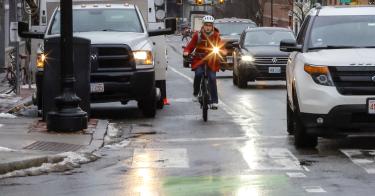No one would expect a dangerous bike lane in beautiful Petaluma. But the City Council is considering building new bike lanes along D Street, a designated truck route with a fire station, named by Sonoma County’s High Injury Network as a street with the most severe injuries.
The new lanes are unnecessary, since nearby B Street, which is not a truck route, already has dedicated bike lanes. The proposal, which is scheduled to come to the City Council for a vote on April 8, should be rejected on safety grounds.
Petaluma boasts that it is “Sonoma County’s gateway to wine country and the Pacific Ocean.” Tourists, unfamiliar with the area, rent bicycles and will not know that the D Street bike lane is close to trucks and emergency vehicles. The city has a responsibility for the safety of residents and tourists that it spends funds to attract.
>>> New York’s Crazy Congestion Charge
U.S. cyclists killed in crashes hit a peak of 966 in 2021, according to the latest data available. Crashes accounted for 85% of deaths, and over 60% of deaths happened when cyclists were biking along roads, rather than at intersections. In addition, almost 42,000 cyclists were injured in 2021, up 10% from 2020.
In light of increases in deaths and life-changing injuries, cities should keep cyclists safe. Some bike lanes are safer than others, but placing bike lanes in unsafe areas, such as on truck and emergency vehicle routes, can lead to harm.
One example of many: In 2022, State Department diplomat Sarah Langenkamp, who had recently returned from Ukraine, was killed in a bike lane on a major Maryland road. A Volvo flat-bed truck turned right into a parking lot and hit her. Although it was daylight, the driver in his high cab didn’t see Langenkamp on her bike.
A March 5, 2020, Engineering and Traffic Survey for the City of Petaluma concluded that D Street has “an above-average collision rate.” It is clearly not a candidate for a bike lane.
Cycling can be unsafe even on quiet streets, and adding trucks compounds the danger. On residential streets such as D Street, it’s impossible to structure bike lanes without pedestrians stepping into the lane to cross the street and delivery vans stopping to drop off packages, blocking bike lane access. Even when bike lanes are protected from car lanes with a line of parked cars or a physical barrier, cars and trucks make right or left turns across the lanes at intersections.
>>> Bike Lanes Don’t Make Cycling Safe
Jan Heine, editor-in-chief of Bicycle Quarterly, wrote over 10 years ago, “Any barrier that separates the cyclist visually from other traffic effectively hides the cyclist. This is counterproductive to safety.” This would be far worse on a truck route where the truckers’ elevated positions create many blind spots.
The D Street bike lane would harm the community by eliminating 120 parking spaces used by homeowners and members of the Petaluma United Methodist Church. Rev. Robert Herrmann is concerned that elderly and handicapped congregants won’t have parking for access to Sunday worship or mid-week activities, such as Alcoholics Anonymous and quilting.
Cyclists should be discouraged from biking on truck routes. Petaluma should place bike lanes where fatalities and injuries will be minimized—both for residents and tourists.
This piece originally appeared in the Petaluma Argus Courier




